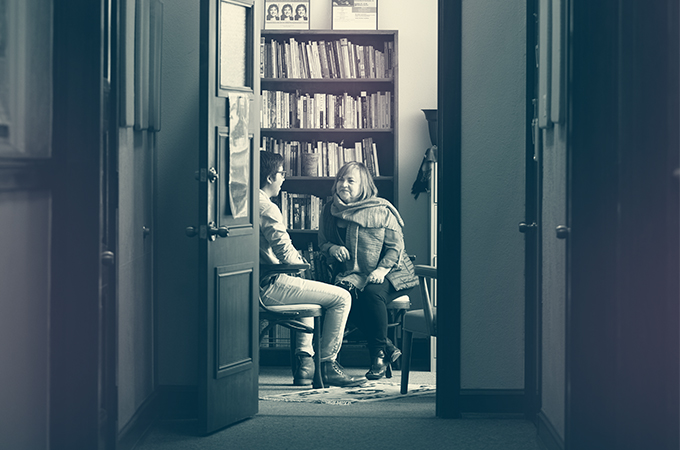What is the impact of mentorship? Five Bulldog stories answer that question and show how far caring, commitment, and community can go, as the effects ripple through the generations.
Embracing the ‘most important role’
John Zepeda ’18, ’20 had a dilemma. The nontraditional student had transferred into the University of Redlands as a junior. Things were going well—he had even picked up Spanish as a second major—until, in his last semester, his sister became critically ill.
A bone marrow donor and a primary caretaker for her, he thought he might need to withdraw from the University as he helped nurse his sister back to health. But then there was Professor Ivonne Gordon-Vailakis.
“Professor Vailakis was … willing to take the extra time to work with me [so I could] obtain both my bachelor’s degrees,” Zepeda says. “She spent several hours of her own time to ensure that I met every requirement.”
Stories like this abound when students and alumni talk about Gordon-Vailakis, a Quito, Ecuador, native who has taught Spanish and Latin American literature at the University of Redlands for more than 25 years.
Gordon-Vailakis views education as a journey, where her students ask, “How do I connect to myself, my society, my community?” Mentorship is a natural by-product of that perspective, according to Gordon-Vailakis, who encourages her students to explore a range of possibilities.
It helps that students have authentic conversations with Gordon-Vailakis during her classes. After publishing eight books of poetry (with two more forthcoming), she shares a passion that excites her students. “Poetry is a tool for transformation,” she says. “My students know I am passionate about poetry. They know that I create and share it, not just with them, but with people in different parts of the world.”
Her mentorship takes different forms, as she responds to the specific needs students bring. In her first few years at Redlands, Gordon-Vailakis started an organization called the Latina Network for first-generation students who felt lost at the University (work that is now folded into the Office of Campus Diversity and Inclusion). “When I started at Redlands, there was only a very small community of students of color,” she says. “It was important for me to be a strong role model as a Latina. I wanted students to know that they were not alone.”
Diego Fernandez ’07, now a professor at the College of the Holy Cross in Massachusetts, was one of the students whose horizons Gordon-Vailakis expanded. “When I was 19, she invited me to teach a brief lesson,” he says. “I have not stopped teaching since.” Gordon-Vailakis became his advisor, mentor, friend, and now colleague. “Her impact is beyond measure,” he says.
Of course, the University of Redlands is a special place, as Gordon-Vailakis points out: “Here, you nurture the individual student. Classes are small, students have to participate, and you can have that personal touch. We have many opportunities to empower students.”
In Gordon-Vailakis’s office, a poster created by students as a gift to her sits among framed covers of her books, her Professor of the Year awards, and other trophies. Faded and yellowed, the poster depicts the image of a tree, with words beside it now barely legible: “¡Los Arboles Iluminados! (Lit Trees!)” in large letters and, beneath that, “Estamos creciendo en la luz … (We are growing in the light).” The poster, which goes back to 1991, her first year at Redlands, reflects Gordon-Vailakis’s philosophy on teaching: She tends to her students as they grow, even beyond Redlands.
“I used to tell my students all the time that they were growing under the light of the trees,” she says, smiling. “I don’t think there is a more important role for a faculty member at the University of Redlands than mentoring students.”
Coming full circle with Big Buddies
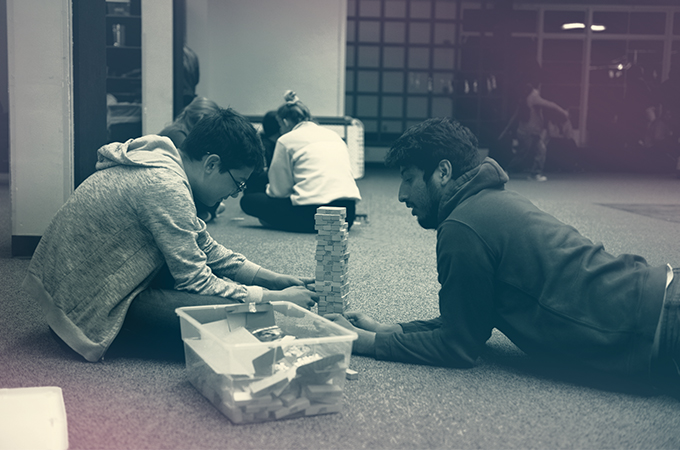
Ayetzy Presa ’20 met her first mentor in middle school after her parents—immigrants who hadn’t gone to college themselves—enrolled her in the Big Buddies program offered at the U of R. “I think my parents were just hoping that someone would help me fill out my college and scholarship applications,” she says.
Little did they know that Big Buddies would open a door for Presa to much more: lifelong friendships, a passion for educational justice, and a desire to become a role model herself.
The Big Buddies program, which began serving the Redlands community 30 years ago, provides mentorship to Little Buddies (ages 6 to 10) and Middle Buddies (ages 11 to 14). Participants can continue to be mentored by transitioning into CHAMPS (College High School Alliance Mentoring Program with Service). There are currently 20 student-mentor pairs in CHAMPS, and 60 in Big Buddies.
Presa’s U of R mentors exposed her to college life, served as sounding boards for her problems, and proofread her essays. Most importantly, they made time for her each week. Presa says, “It was important just to have someone who wasn’t a parent, a counselor, or a teacher giving me advice and saying, ‘I’m here for you.’”
And that is how the program is supposed to work, according to Community Service Learning (CSL) Director Tony Mueller. “Big Buddies and CHAMPS are programs that foster mentorship and encouragement. Although we offer tutoring for each program, the goal of Big Buddies is really to create strong relationships.” CSL maintains separate programs, such as Jasper’s Corner Homework Club, specifically for tutoring children.
Nora Godfrey ’17, now an educational assistant at Ashland High School, mentored Presa in CHAMPS. “Mentors can be the bridge between your potential and your success,” says Godfrey, who also benefited from mentors across campus. “We need a push; we need resources we may not have; we need love. Good mentors will help bridge that gap in any way possible.”
Thanks in part to her mentors like Godfrey, Presa stayed on task, finishing high school and enrolling in college at California Lutheran University in Thousand Oaks. After her first year, she realized that U of R was a better fit for her and transferred.
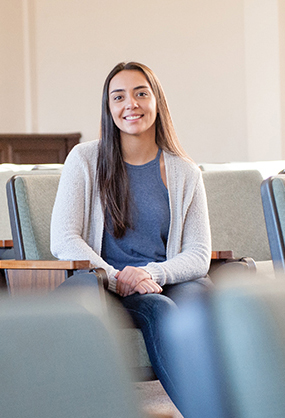
“At Redlands, I’ve had amazing professors,” says Presa, who is double majoring in history and religious studies. “If I have a question, I can sit in their offices and talk to them for two hours. I’ve gotten job recommendations just by having a class with a professor. When I wanted another major, my professors said, ‘We can make this happen,’ and worked with me to get it done.”
Today, along with Hannah Albrecht ’21 and Lisa Elliott ’19, Presa is a co-director of U of R’s CHAMPS, the same program that had such a huge impact on her.
“[CHAMPS] is open and welcoming, and we don’t segregate our special needs students, which helps create an atmosphere of equity,” says Presa, who eventually wants to get a master’s in education and teach in underserved areas. “There’s definitely an emphasis on inclusivity and giving back to the community here at Redlands.”
The next generation of cancer research
Despite having graduated decades apart, Lawrence (Larry) Lum ’69, M.D., D.Sc., and Johnson Ung ’17 share a fascination with science, a commitment to hard work, and life-changing experiences through the U of R. Now they also share a common goal and a mentorship bond as they work together to advance groundbreaking immunotherapeutic cancer research.
“A number of University of Redlands alumni have worked with Dr. Lum through the years, and I am tremendously grateful to be one of them,” says Ung. “He treats me like a postdoctoral researcher so I can learn to efficiently formulate, plan, and execute experiments. His decades of experience are more insightful than any textbook.”
Lum is the Marion McNulty Weaver and Malvin C. Weaver Professor of Oncology Endowed Chair, the director of cellular therapy, and scientific director of bone marrow transplantation at the University of Virginia (UVA), Charlottesville, and he is happy to have Ung in his lab, fondly referring to him as a “scientific sponge.”
“Mentoring Johnson gives me personal satisfaction because stimulating his mind leads to new insights for both of us,” Lum says. “We grow and learn together.”
Both Lum and Ung are building on foundations laid nearly 2,500 miles away at the University of Redlands.
Lum was a chemistry major at Redlands, where Professors Julian Roberts and Jim Ifft were major influences. “They really believed in independent study and were very interactive, very available, and got us involved in summer research,” says Lum.
Later, as a first-year medical student at University of California, San Francisco, Lum traveled to Copenhagen to complete his summer fellowship research with Ifft, who was on sabbatical in a lab where three Nobel Prize winners had conducted research. “If it weren’t for Jim,” Lum states emphatically, “I would not be where I am now.”
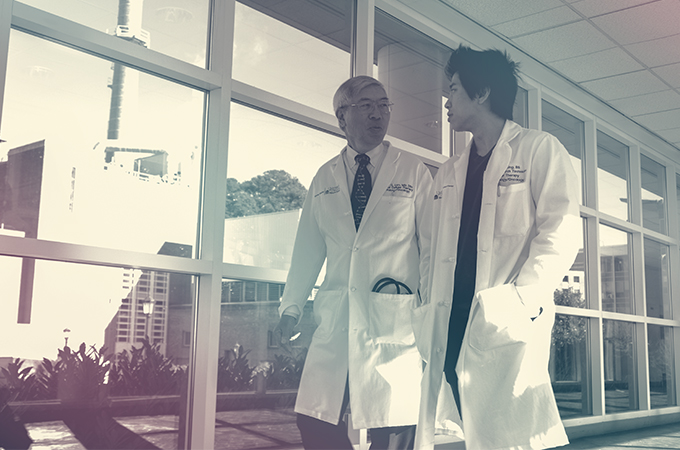
Today, Lum’s lab conducts research that augments a patient’s own immune cells to combat cancer. Called bispecific antibody armed targeted T cells (BATs), these specialized cells, armed with a chemically conjugated bispecific antibody that binds to both T cells and cancer cells, secrete an array of proteins that attack the cancer and attract other immune cells. The destruction of the tumor by a patient’s own T cells leads to vaccination against that specific tumor.
In related work, Lum, who received an honorary doctorate of science from the U of R in 2000 and the U of R Alumni Centennial Award in 2007, is developing a cellular treatment for patients with type 1 diabetes.
For his part, Ung, who majored in chemistry and biology at Redlands, was introduced to the world of clinical research by U of R Professor of Biology Ben Aronson, who recommended an internship opportunity at Seattle’s Fred Hutchinson Cancer Research Center. The internship helped Ung land a position in Lum’s lab. Ung admits that working with Lum and his group was nerve-wracking at first, but, over time, he eased into his job and found a sense of belonging.
The experience has inspired Ung to pursue a Ph.D., which could lead to an opportunity to run his own lab. He will begin UVA’s doctoral program in biomedical science in the fall. “It is my hope to contribute to society not just by developing new therapies or making scientific discoveries,” Ung says, “but also by passing down knowledge and expertise to continue the science of my predecessors.”
‘Why not me?’
This year, Jeremy Cervantes ’17, ’19 selected a special theme for his fourth-grade classroom at Morongo School, located on the Morongo Band of Mission Indians reservation. The doors and bulletin boards are plastered with an array of superheroes, which Cervantes selected to inspire his students.
“As a child [from the Morongo tribe], I saw a need for positive tribal role models, especially teachers,” says Cervantes. “I thought, ‘Why not me?’”
Cervantes, who earned a bachelor’s in liberal studies and sociology/anthropology at the University of Redlands, is currently working on his master’s in learning and teaching (MALT) through the School of Education. “A student pulled me aside and said I was his favorite teacher because I listened to him and genuinely cared what he had to say,” Cervantes says. “I definitely learned that approach at Redlands.”
Fellow Bulldog and Morongo School first-grade teaching assistant Dominique Lombardi ’17, a member of the Morongo tribe, also recalls her desire from a young age to work at a tribal school. She reports being “painfully shy” as a child, but through her involvement with UNITY (United National Indian Tribal Youth), a nonprofit organization that develops young Native leaders, Lombardi learned to “step out of her comfort zone”—a message she sends to her students: “I tell them to let your voice be heard, and things can change if you set your mind to it.”
Like Cervantes, Lombardi, who intends to enroll in U of R’s MALT program, clearly sees the Redlands influence in her teaching. She credits Larry Gross, San Manuel Band of Mission Indians Endowed Chair of Native American Studies, with supporting her while she earned a bachelor’s in race and ethnic studies and liberal studies. “Larry taught me to teach as a storyteller, which I integrate in my classroom today,” says Lombardi. “And, when my father had brain surgery the
first day of my senior year, he was there for me.”
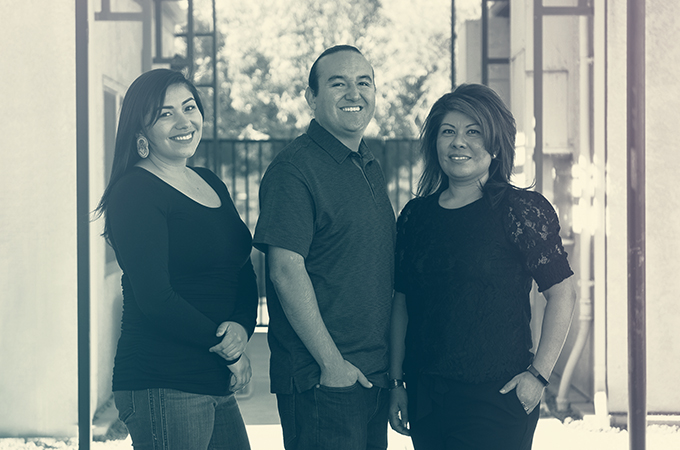
Both Cervantes and Lombardi were actively involved with the University’s Native Student Programs (NSP), made possible through the generous leadership support of San Manuel Band of Mission Indians. There, staff provided strong examples of mentorship. “[NSP staff members] built a community where we felt included and could get advice,” says Lombardi. “It was fulfilling to know I was contributing to helping others feel that same sense of belonging.”
Morongo School teacher and Northern Ute tribal member Monica Noble ’16, ’19
teaches seventh grade through ninth grade and also appreciates how much Redlands supported her. “I always knew I wanted to work with Native people,” reflects Noble, who began her career as a court advocate for her tribe in Utah. As a single mom, Noble worked full time while attending the School of Education. As a nontraditional student, she benefited most from NSP’s networking opportunities, which reinforced the importance of positive mentors; she also took the opportunity to volunteer in NSP’s outreach programs, inspiring youth to pursue higher education. Today, she says, “I have high expectations for [my students] and push them hard. Sometimes it’s not easy, but the impact you have influences what they will do in the future.”
One of Cervantes’s classroom bulletin boards features the “Bat-Signal” from the famed Caped Crusader and a quote that reads, “Our greatest glory is not in never falling, but in rising every time we fall.” Cervantes is committed to helping Native students better themselves and hopes a few of his students will attend Redlands one day.
“I want them to see they can do anything if they have the right encouragement,” says Cervantes. “They can all be heroes, too.”
Making the most of mentoring
Carla Carlini ’11, ’12 hesitated when she heard from Christine Taitano, the University’s director of student services and head of the School of Business Mentor Program. The president and general manager of Los Angeles-based educational cable access channel LA36 and active mentor in the program since 2013, Carlini thought the call might be about a new assignment but didn’t feel she had the bandwidth at that moment to take on a new mentee.
But Taitano simply asked if Carlini would be willing to have a conversation with recent College of Arts and Sciences graduate Allison Torrance ’17. “I agreed, and the next thing I knew I was offering Allison an internship,” says Carlini with a laugh.
Torrance was thrilled. The theater major had been unlucky in her job search until a casual conversation with Taitano, who happened to be the mother of a friend, led her to Carlini. The television executive proved to be just the mentor Torrance hadn’t realized she needed.
Torrance began interning at LA36 in September 2017, seizing every opportunity to learn about video editing, graphics, and production. In January of 2018, she moved into a part-time production assistant role at the station and more recently started another part-time job as an editor and production assistant at Torrance CitiCABLE, thanks in part to introductions made by Carlini.
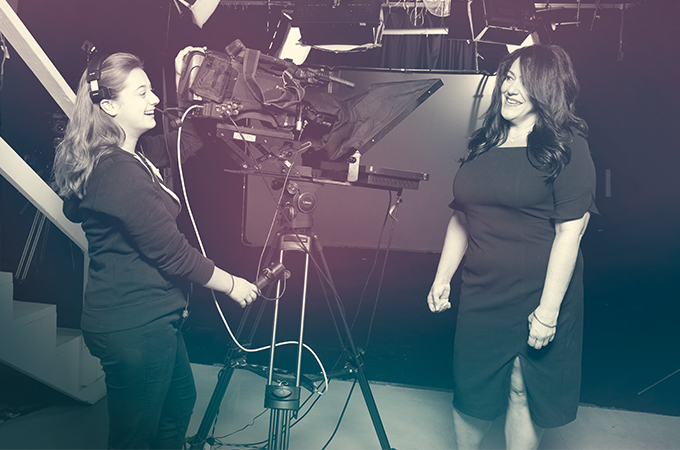
“When I work with a student mentee, my aim isn’t to give that person a job, although in Allison’s case that’s what eventually happened,” says Carlini.
“My goal is to foster confidence and provide the skills and tools the individual will need to find employment. I see myself as a guide—I’m there to support and encourage.”
Mentoring is something of a lost art, Carlini continues, and a relationship that demands a commitment from both parties. Torrance gave 100 percent. “Not only was she really eager to learn, but she also leveraged her knowledge and experience to earn a job at LA36 and then at Torrance CitiCABLE.”
Although she has never had a formal mentor, Carlini says many people have taken her under their wings over the course of her career, and she sees the value such experiences bring.
“Redlands taught me that whatever you do in life, you’re going to be dealing with people and you have to get buy-in to succeed,” says Carlini. “You can’t be a machine, you need to bring humanity to the workplace. You’ve got to step back and get the big picture, and mentoring is a part of that for me. I learn as much from the mentees as they learn from me.”
Torrance, too, credits Redlands for teaching her the power of keeping the big picture in mind. “As a student, I learned how important it is to keep asking questions, meeting new people, and trying new things,” she asserts. “I wouldn’t be where I am today if I didn’t network and step outside my comfort zone.”
And Carlini has shown her that process is not only possible, but fun. “Carla has been great—she’s strong and hard-working and has taught me a lot. She has inspired me, and I hope that someday I can do the same for someone else.”
Read more stories from the latest issue of Och Tamale magazine.

